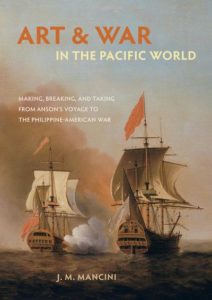Mancini, J.M. Art and War in the Pacific World: Making, Breaking, and Taking from Anson’s Voyage to the Philippine-American War. Oakland, California: University of California Press, 2018. Xxi+318 pp., ISBN 9780520294516
By Ashleigh Dean, Assistant Professor, Georgia College and State University, Milledgeville GA
 Art and War in the Pacific World: Making, Breaking, and Taking from Anson’s Voyage to the Philippine-American War by J. M. Mancini is a remarkable work that provides a detailed examination and analysis of a little-studied aspect of trans-Pacific history. Mancini’s approach focuses on art and architecture across the Pacific in the context of imperial influence from both Great Britain and the United States to provide a unique analysis of a vital area of art history. It is divided into two parts of three chapters each, one focused on British incursions into the Pacific and their conflicts with the Spanish in the eighteenth century and the second examining the American imperial experiment in the Philippines between 1898 and 1910. With 117 illustrations representing a little-studied aspect of Pacific artistic history, this book provides valuable insight into the art and culture of the eighteenth through twentieth centuries.
Art and War in the Pacific World: Making, Breaking, and Taking from Anson’s Voyage to the Philippine-American War by J. M. Mancini is a remarkable work that provides a detailed examination and analysis of a little-studied aspect of trans-Pacific history. Mancini’s approach focuses on art and architecture across the Pacific in the context of imperial influence from both Great Britain and the United States to provide a unique analysis of a vital area of art history. It is divided into two parts of three chapters each, one focused on British incursions into the Pacific and their conflicts with the Spanish in the eighteenth century and the second examining the American imperial experiment in the Philippines between 1898 and 1910. With 117 illustrations representing a little-studied aspect of Pacific artistic history, this book provides valuable insight into the art and culture of the eighteenth through twentieth centuries.
Mancini makes two extraordinary contributions to the cultural and artistic historiography of the region. The first is her situating David Weber’s argument for British and American historical animosity towards Spain representing a single continuum in the context of the Pacific in general and the Philippines in particular. This allows her to present the Anglo-American incursions into the Pacific as part of a joint anti-Spanish enterprise, stretching across generations and military alliances, thereby centering Anglo-American predations in the Pacific as a major element in the development and destruction of art and culture across the maritime zone.
The second, and by far the most important, is her centering of war, looting, and destruction as vectors in the spread of art and culture across and around the Pacific between the Seven Years’ War and the conquest of the Philippines by US forces at the dawn of the twentieth century. Mancini points out that, traditionally, art across the Pacific has been studied from the viewpoint of more traditional vectors such as commerce and luxury trade, but the Pacific Rim, and especially its history of Anglo-American connections, is really a “world connected by disruption and created by destruction” (p.239). She skillfully analyzes dozens of examples of war’s effect on art without ever drowning the reader in minutiae. Of particular note is her fifth chapter, “Sovereignty Trouble,” much of which focuses on the production of commercial postcards openly depicting American destruction of colonial-era Spanish architecture in the Philippines. Mancini ties these images in with both general advocacy for imperialism and a particular American “third war” against the power of the Catholic Church–itself a stand-in for the departed Spaniards, a common enemy of the recurring waves of Anglophone invasions in the islands. Mancini’s other chapters also elucidate these themes of war and joint Anglo-American enterprise in the Pacific with great skill and verve.
Art and War in the Pacific World represents a valuable opportunity for scholars and students of art, history, war, and culture. Mancini’s work helps to shed traditional commerce-based approaches to art history in an area of the world that historiography has neglected in the past. With the rise of the Pacific World as a viable subfield for both research and pedagogy, this book should be in high demand across multiple disciplines.






